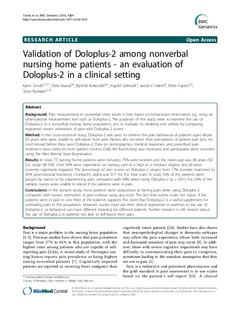| dc.contributor.author | Torvik, Karin | |
| dc.contributor.author | Kaasa, Stein | |
| dc.contributor.author | Kirkevold, Øyvind | |
| dc.contributor.author | Saltvedt, Ingvild | |
| dc.contributor.author | Hølen, Jacob C | |
| dc.contributor.author | Fayers, Peter | |
| dc.contributor.author | Rustøen, Tone | |
| dc.date.accessioned | 2010-09-09T12:21:26Z | |
| dc.date.available | 2010-09-09T12:21:26Z | |
| dc.date.issued | 2010 | |
| dc.identifier.citation | Torvik, K., Kaasa, S., Kirkevold, O., Saltvedt, I., Holen, J., Fayers, P., & Rustoen, T. (2010). Validation of Doloplus-2 among Nonverbal Nursing Home Patients - an Evaluation of Doloplus-2 in a Clinical Setting. BMC Geriatrics, 10(1), 9. doi: 10.1186/1471-2318-10-9 | en_US |
| dc.identifier.issn | 1471-2318 | |
| dc.identifier.uri | http://hdl.handle.net/11250/138657 | |
| dc.description | Published version of an article from the journal: BMC Geriatrics. Also available from the publisher: http://dx.doi.org/10.1186/1471-2318-10-9 | en_US |
| dc.description.abstract | BACKGROUND:Pain measurement in nonverbal older adults is best based on behavioural observation, e.g. using an observational measurement tool such as Doloplus-2. The purposes of this study were to examine the use of Doloplus-2 in a nonverbal nursing home population, and to evaluate its reliability and validity by comparing registered nurses' estimation of pain with Doloplus-2 scores.METHOD:In this cross-sectional study, Doloplus-2 was used to observe the pain behaviour of patients aged above 65 years who were unable to self-report their pain. Nurses also recorded their perceptions of patient pain (yes, no, don't know) before they used Doloplus-2. Data on demographics, medical diagnoses, and prescribed pain treatment were collected from patient records. Daily life functioning was measured and participants were screened using the Mini Mental State Examination.RESULTS:In total, 77 nursing home patients were included, 75% were women and the mean age was 86 years (SD 6.6, range 68-100). Over 50% were dependent on nursing care to a high or a medium degree, and all were severely cognitively impaired. The percentage of zero scores on Doloplus-2 ranged from 17% (somatic reactions) to 40% (psychosocial reactions). Cronbach's alpha was 0.71 for the total scale. In total, 52% of the patients were judged by nurses to be experiencing pain, compared with 68% when using Doloplus-2 (p = 0.01). For 29% of the sample, nurses were unable to report if the patients were in pain.CONCLUSIONS:In the present study, more patients were categorized as having pain while using Doloplus-2 compared with nurses' estimation of pain without using any tools. The fact that nurses could not report if the patients were in pain in one third of the patients supports the claim that Doloplus-2 is a useful supplement for estimating pain in this population. However, nurses must use their clinical experience in addition to the use of Doloplus-2, as behaviour can have different meaning for different patients. Further research is still needed about the use of Doloplus-2 in patients not able to self-report their pain. | en_US |
| dc.language.iso | eng | en_US |
| dc.publisher | Biomed Central | en_US |
| dc.title | Validation of Doloplus-2 among nonverbal nursing home patients - an evaluation of Doloplus-2 in a clinical setting | en_US |
| dc.type | Journal article | en_US |
| dc.type | Peer reviewed | en_US |
| dc.subject.nsi | VDP::Medical disciplines: 700::Health sciences: 800::Nursing science: 808 | en_US |
| dc.source.pagenumber | 9 s. | en_US |
